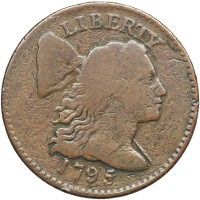
Most of the 1795 Liberty Cap Large Cents (Buy on eBay) produced at the Mint were struck on planchets with a plain edge, a smaller number had a lettered edge, and a tiny fraction were struck on planchets with a reeded edge.
While the official purpose of the reeded edge remains unknown, most have suggested that the coins were created as an experiment to prevent counterfeiting or clipping. Clipping occurred when someone either filed or clipped the edges of a coin to remove a portion of the metal. This was primarily a problem with silver or gold coins, rather than copper which had a much lower value. Whatever the purpose, the experiment was quickly abandoned as unnecessary or not cost effective.
Only nine examples of the 1795 Reeded Edge Large Cent are known to exist. All pieces are struck from the same die pair. An example graded VG-10 sold for $1,265,000 at an auction held in September 2009. More recently, an example with fine details and corrosion sold for $431,250 in January 2011. That piece had been called the discovery coin and originally considered graded Net G-5.

